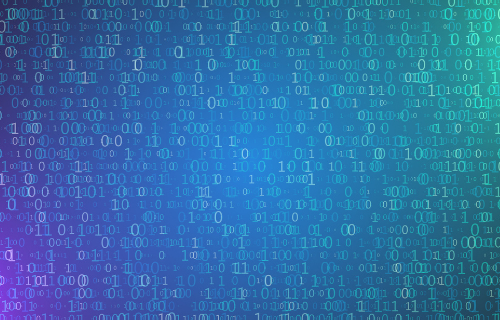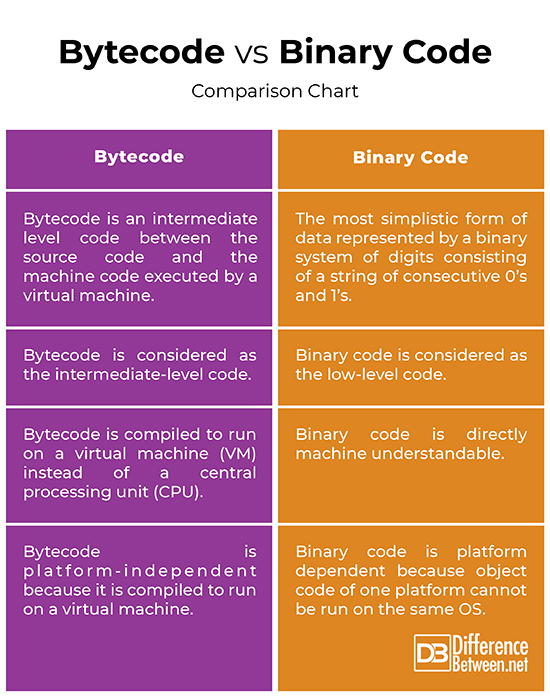Difference Between Bytecode and Binary Code
Not every software development platform produces executable machine code that runs directly on a processor. Those platforms that do not produce executable machine code generate some kind of intermediate representation of the program, or bytecode. This bytecode is then read by a special program on the user’s machine, which executes the program on the local processor. This program is called a virtual machine. Binary code is completely different from the byte code and is directly machine-understandable. However, the difference between bytecode and binary code has slightly blurred during the past few years.

What is Bytecode?
Bytecode is an intermediate code between the source code and the binary code compiled to run on a virtual machine (VM) instead of a central processing unit (CPU). It is essentially a low level code that is just like a hardware processor’s assembly language (such as the IA-32 assembly language). The interesting thing about virtual machines is that they almost always have their own bytecode format. The difference is in how such binary code is executed.
Bytcode is a highly optimized set of instructions designed for efficient execution by a software interpreter. No real world hardware CPU carries out these instructions. Bytecodes are usually distributed in a single-file package, which may need to be unpacked to obtain the individual bytecode files for decompilation into source code. Bytecodes are compact numeric codes, constants, hexadecimal, and numeric addresses.

What is Binary Code?
A binary code represents a letter, digit, or other character in a computer. It is basically a coding system that most computers and computerized devices use to send, receive, and store information. Binary simply represents a numbering scheme that uses only two values: 0 and 1. It represents computer processor instructions or any other data that uses only these two values. It is the most simplistic form of data represented entirely by a binary system of digits consisting of a string of consecutive 0’s and 1’s.
Machine code uses sets of binary digits to create instructions. Binary code is also used to represent the smallest amount of data that flows through almost all complex software and hardware systems that are used to handle most of today’s data resources and assets. In fact, the nature of binary code and data plays a significant role in the fundamental world of information technology. Most modern computers use binary encoding for instructions and data.
Difference between Bytecode and Binary Code
Basics
Unlike conventional binary programs, in which each instruction is decoded and executed by the hardware, virtual machines perform their own decoding of the program binaries. Binary code, as the name suggests, is in binary format (0’s and 1’s) which is completely different from the bytecode, which is considered as the intermediate-level code compiled to run on a virtual machine instead of a CPU. It has been compiled from source code into low-level code designed for a software interpreter.
Format
Bytecodes are compact numeric codes, constants, hexadecimal, and numeric addresses. It is an intermediate code between the source code and the binary code compiled to run on a virtual machine (VM) instead of a central processing unit (CPU). Binary code is the most simplistic form of data represented entirely by a binary system of digits consisting of a string of consecutive 0’s and 1’s. Binary code is considered as the low-level code.
Platform Dependency
Bytecode is platform-independent because it is compiled to run on a virtual machine and the system with a virtual machine can be executed regardless of the platform. Binary code, on the contrary, is platform dependent because object code of one platform cannot be run on the same OS. Different virtual machine is designed for different OS and bytecode is able to run on different OS. Bytecode runs only when the interpreter is available.
Bytecode vs. Binary Code: Comparison Chart

Summary
Bytecode is a highly optimized instruction set designed for efficient execution by a software interpreter. No real world hardware CPU carries out these instructions. Binary code represents computer processor instructions or any other data that uses only these two values. Machine code uses sets of binary digits to create instructions. Machine code is composed of instructions from the CPU’s instruction set, which is a computer’s built-in set of commands. A compiled program composed of machine code is called a binary.
What is bytecode example?
A popular example of bytecode is Java bytecode, which is compiled from Java source code and can be run on a Java Virtual Machine (JVM).
What is the difference between bytecode and object code?
Bytecode is an artificial machine code for a virtual machine (VM), such as the Java Virtual Machine (JVM), whereas object code is a code produced by a compiler or assembler.
Why is it called bytecode?
The name ‘bytecode’ comes from instruction sets that have one-byte opcodes followed by optional parameters.
What is Java bytecode and how does it differ from machine code?
Java bytecode is the instruction set for the Java Virtual Machine (JVM). It is an intermediate level code between the source code and the machine code executed by a virtual machine. Machine code, on the other hand, is a low level code which can be directly understood by computers.
- Difference Between Caucus and Primary - June 18, 2024
- Difference Between PPO and POS - May 30, 2024
- Difference Between RFID and NFC - May 28, 2024
Search DifferenceBetween.net :
Leave a Response
References :
[0]Jablonski, Stefan, et al. Guide to Web Application and Platform Architectures. Berlin, Germany: Springer, 2013. Print
[1]Eilam, Eldad. Reversing: Secrets of Reverse Engineering. New Jersey, United States: John Wiley & Sons, 2011. Print
[2]Sweigart, Al. Beyond the Basic Stuff with Python: Best Practices for Writing Clean Code. California, United States: No Starch Press, 2020. Print
